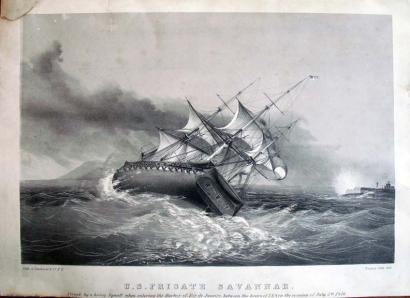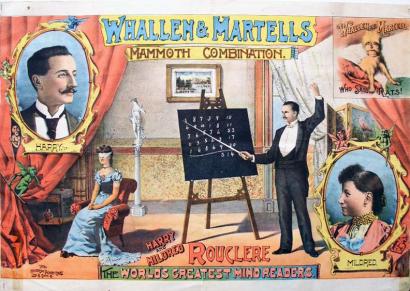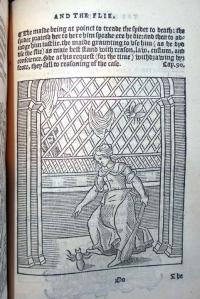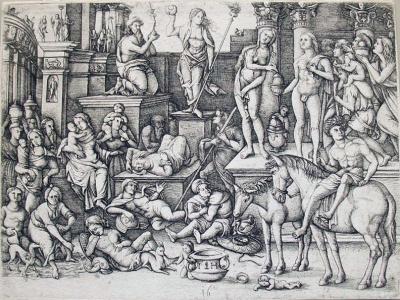


Artist unknown, Trip to Town (London: William Sams, 1822). Box embossed: E.P. Sutton & Company; Sangorski & Sutcliff. GA 2005.01039
Last August, we posted this twelve-plate panorama and asked if someone could confirm the attribution to Thomas Rowlandson, even though there is no artist’s signature on the item. Our London colleague Jonathan Gestetner has now written to us about his copy of the 29.5 foot panorama and confirms that it should not been attributed to Rowlandson. In fact, no artist can yet be credited for this comedy about Mr. and Mrs. O’Squat. I include Mr. Gestetner’s description below. His print is the same as Princeton’s except it was published the following year. Ours is housed in an elaborate viewing case and the London copy is in a hand-held drum.
Trip to Town (London: William Sams, 1822). Handcolored etching.
British satirical, narrative panorama consisting of twelve scenes rather than one continuous image. The coloured etching pasted to the drum consists of the title, and a view of a showman with two realistic puppets of a man and a woman who are made to dance. The showman attracts attention by blowing on a pipe and beating a tambourine. A second man blows on a bugle. A crowd watch the show with rapt attention. Above the image are four lines of verse: The Puppets thus unconscious move/ In shew of happiness and love,/ They raise a smile, a laugh, and roar,/ And then their giddy dance is o’er. Below is the imprint: Published by W. Sams, Bookseller to his R.H. the Duke of York, No. 1 St James’s St., London, 1823.
The stay is made of board; a silk tab attached to it also facilitates the panorama’s extraction. The story on the panorama itself advances from r. to l., each scene being introduced by lines of verse on draped cloth. On the first we learn that Mister O’Squat, quite full of Life/ Sought Widow Shanks to be his wife. Both seek matrimonial treat without any concern for money. In the later scenes O’Squat experiences a humiliating fall. The couple spurn the ‘rusticated state’, and head off on an irresponsible frolic for London.
On the way their gig falls apart, emptying them into a pond. In St James’s Park Mrs O’Squat flirts and her husband learns from his newspaper about sharps and flats whilst having his pocket picked. He gets drunk at a civic feast; with Mrs O’Squat apes delight at a concert, attends a masquerade, is accident prone at billiards, and promenades on Rotten Row. At a military review he has trouble with a bolting horse. Finally the couple are hounded by creditors, and O’Squat is attended by doctors. Mistress Squat in doleful dumps withdrew, we are told, But what became of Squat we never knew.































Recent Comments